| 1 | A shy forest species |
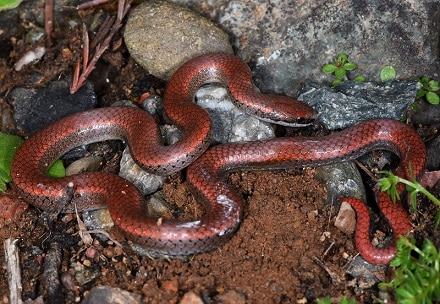
In California, you can find Pacific rattlesnakes slithering down sidewalks, following dog walkers just for fun. You can find California kingsnakes slithering past picnic benches, searching for a mammal burrow to invade. Many Californian snakes coexist easily with humanity. But one species is much harder to find – the sharp-tailed snake (Contia tenuis).
This species is closely related to the mud snake of Florida, and is just as harmless, but has a wildly different lifestyle. The sharp-tailed snake spends most of its life in forests, with a thick undergrowth of fallen leaves and mulch, and old rotting tree branches. Sharp-tailed snakes not only prefer pristine forests, but are tiny, with an average length of just 30cm.
Sharp-tailed snakes avoid open areas like the plague; you’ll rarely see them in a cow field. Sharp-tailed snakes are like the western version of the ring-necked snake of Louisiana, another shy snake which always lives under cover (despite the two sharing no relation). In fact, these two have been have found sheltering together in the small area where the species overlap.
| 2 | Buries itself in forest mulch |
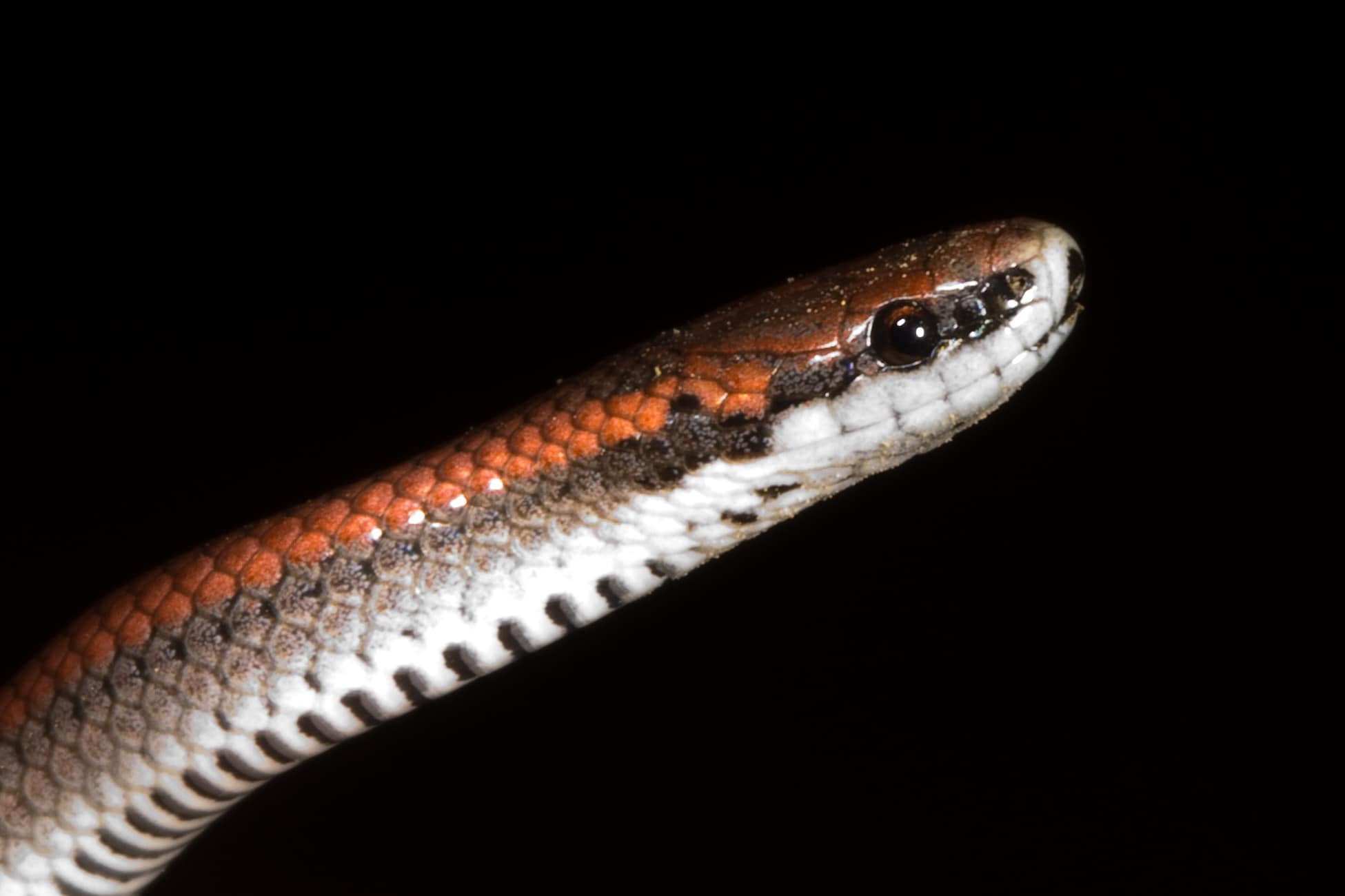
Unlike the constantly exploring coachwhip, the sharp-tailed snake is a shy species which nearly always sticks to shelter. Within their forest domains, this species is nearly always found under some sort of cover. They might be buried below a leaf bed, inside a rotting log, or beneath rotting strips of bark alongside millipedes. Ripping up logs in pristine Californian forests is the best way to find them, but equally, your efforts might be in vain, if you happen to choose the wrong forest. There’s no way of telling until you get there.
From late spring to early autumn, sharp-tailed snakes disappear completely, retreating deep into underground mammal burrows. They possesses basic burrowing abilities of their own, although they tend to use ready made shelters. Despite their shy forest nature, sharp-tailed snakes also appear in urban areas sometimes, if they have sufficient debris like cardboard boxes and sheet metal lying around. But you’d still be lucky to find one in your back garden.
Adding to the disappearing act is that sharp-tailed snakes are mostly nocturnal. Even in areas where they’re known to be common, such as Oregon, sharp-tailed snakes are rarely seen by the layman. Within forests, sharp-tailed snakes often reside near shallow streams; they always need moisture to thrive. They also dislike overly warm temperatures.
| 3 | Less common further north |
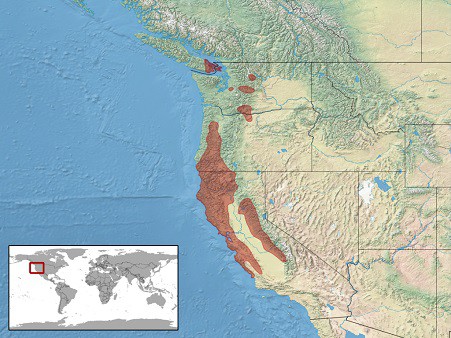
In the USA, sharp-tailed snakes are found in 3 states; California, Oregon and Washington. The first two are their heartlands, where they’re fairly abundant in the forests, despite rarely being seen. The further north you travel, the rarer sharp-tailed snakes become. Their Californian domains include the Eureka mountains, and western slopes of the Sierra Nevada up to a maximum of 2130m in elevation.
They also have colonies in British Columbia, Canada. Originally these were limited to southern Vancouver Island, and the nearby Gulf islands, but in 2011 a new colony was discovered in Pemberton, along a wooded ridge targeted by builders for development. Scientist were searching for the rubber boa, but instead came across the shy sharp-tailed snake, 10 in total. It’s believed that this shy snake has many more undiscovered colonies.
To the east, sharp-tailed snakes come nowhere close to adjacent snakes such as Nevada, Idaho and Montana. They also exist well to the north of Los Angeles, skipping the southern portions of California.
| 4 | Pokes prey with its tail |
If you luckily stumble across a sharp-tailed snake and bend over to pick it up, it won’t bite. This species is neither venomous, nor capable of ripping a predator’s flesh into a grisly mess with its teeth. Instead, Contia tenuis will probably poke you with its tail, causing a sharp pain, but no serious damage. It’s possible that this evolved to mimic a sharp bite and scare bird predators off.
Like many snakes, sharp-tailed snakes sometimes curl up when threatened, but they particularly favour a pretzel shape, to make it harder for predators to swallow them whole.
Sharp-tailed snakes are more aggressive than some 30cm species; they sometimes flatten their lower body against the ground, and raise their upper body in an s-shaped coil like an eastern brown snake. Then they lunge at the aggressor, despite having no venom to back it up. One sharp-tailed snake bluff striked so far that it toppled over forwards onto the forest floor. Despite seeming a bit desperate, bluff strikes like these often succeed in scaring birds, by providing an illusion of bigger size.
| 5 | Record: 47.5cm |
The sharp-tailed snake also stays hidden using its tiny size. Adults average at 30cm with an absolute maximum of 47.5cm, while newborns are only 6-7cm. This is compounded by a thin, twig like body, no thicker than pencil. The Arabian sand boa is another 30cm snake, but looks much larger because of its thick stubby body.
The sharp-tailed snake has round pupils, and the eyes are cloaked by large black patches like a mask. They can look quite similar to young garter snakes, but sharp-tailed snakes have smooth scales rather than rough. One of the sharp-tailed snake’s signatures is their banded belly patterns, like a black and white barcode.
This is mainly a browny, clay red snake. Younglings have more noticeable lined patterns on their sides, which fade in adulthood. Instead, adults have more subtle alternating patterns between red and brown, looking more interesting up close compared to further away. Sharp-tailed snakes are also identified by a white chin, which contrasts sharply with their black eye mask.
| 6 | Highly endangered in Canada |
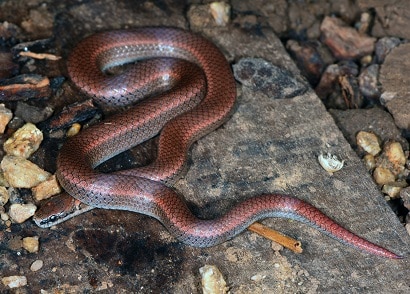
In British Columbia, the sharp-tailed snake may be in mortal peril. It’s now listed on British Columbia’s local red list for critically endangered. Its population is highly fragmented, and even the surviving pockets are no more than 3km wide. Their hub in Canada is Vancouver Island, but the last 100 years have seen vast deforestation to make way for farmland and housing estates. It’s estimated that Vancouver Island has 0.5% of its old forest cover remaining, forests older than 120 years. The specific ecosystem they rely on is coastal Douglas-fir forests.
Many of the fragmented pockets are on private woodland, behind closed doors with no legal protection. Another fear is agriculture, pesticide runoff which could be killing their slug food staple. Contia tenuis is in a similar boat to the Kirtland’s snake of Ohio; it never travels long distances and hence, cannot naturally replenish other colonies. Sharp-tailed snakes have a home range of 25 metres, and some never leave this over their entire life.
| 7 | Diet: exclusively slugs |
The classic feature of the sharp-tailed snake is the tail itself. It’s sharp and pointy, spiky like a rose thorn, and this relates to their diet. The sharp-tailed is a slug-eater, rummaging around its moist soily domains to find an endless supply of them. It’s theorised to eat slug eggs and maybe earthworms as well, but slugs are the sole prey they’re known to eat.
A 1947 study in Oregon analysed the stomach contents of 23 dead sharp-tailed snakes. 6 contained slugs, and no other animals were found. A Californian study was similar; 67 snakes, with 9 containing slugs. The spiny tail is believed to be for hunting these slimy slugs, skewing them like a kabab, before swallowing them alive. They also use the tail for stabilising themselves in the soils.
Another physical feature is their backwards curved teeth. These are used for gripping the slippery slugs inside their mouths, and preventing their escape. These teeth are also relatively large for the sharp-tailed snake’s small size. The main slug they’ve been recorded eating is the introduced arion family from Europe.
| 8 | Copies millipedes for protection |
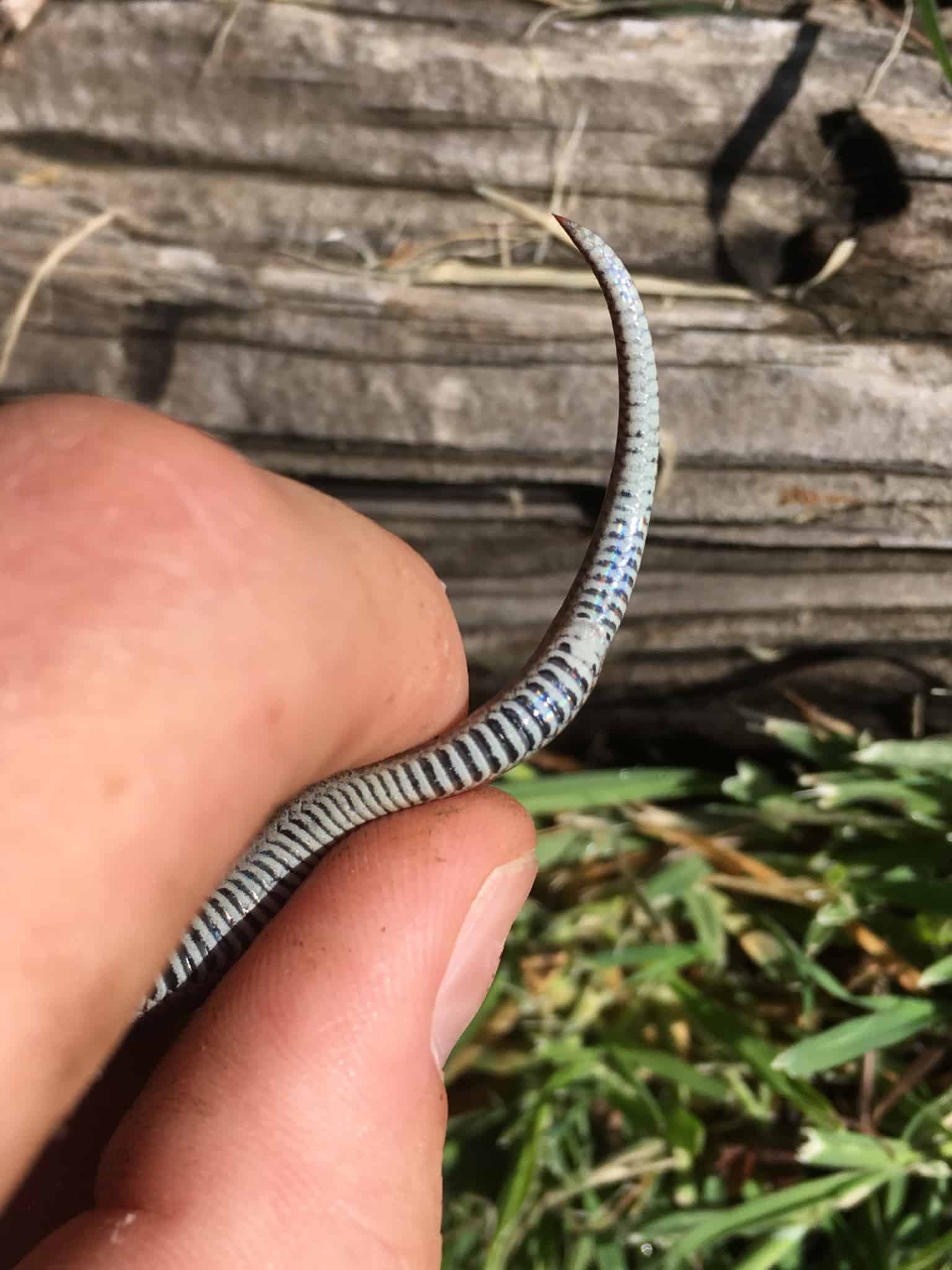
The sharp-tailed snake is hunted by steller’s jays and has been found in the stomach of the western toad (Bufo boreas) before. They also have a confirmed fish predator: the 30cm long brook trout. Another cool feature is dark spots on the chins of newborns, which are theorised to mimic eyes and terrify predators away.
There’s also a theory that sharp-tailed snakes have evolved to mimic millipedes. Many California millipedes such as Tylobolus claremontus are deadly poisonous, with enough toxins to wipe out a San Diego alligator lizard. Millipedes and sharp-tailed snakes share similar environments such as moist forests, and their signature black and white banded belly resembles them quite strongly.
Biologists have noticed that when they rip away forest mulch cover, exposing their dens, sharp-tailed snakes often have their belly facing outwards, like a default resting defence strategy, possibly to scare birds into instantly retreating. When they bury themselves, the sharp-tailed snake’s disguise can be so effective that a hiker would never realise they’re seeing a snake. You can sometimes spot their belly through layers of bark peeling off a log, but the black and white bands look more like worms or millipedes.
| 9 | New colony: San Juan Island |
The optimistic element is that the Canadian colonies have always been rarely sighted. The first B.C. sharp-tailed snake was discovered on Vancouver Island sometime in 1857-1861, during an exploratory voyage by HMS Plumper. It took nearly 90 years for the second B.C. snake to be found, on North Pender Island in 1949,
The 2011 Pemberton discovery shows that new colonies may be out there. Further south, the sharp-tailed snake was discovered for the first time on Washington’s San Juan islands in 2006. Ruthie Dougherty and Doug McCutchen were constructing a trail on Turtleback mountain, when they lifted a rock and uncovered the shy snake. It didn’t look like any snake they’d seen before, and it wasn’t. This was also the first Contia tenuis in west Washington state since the 1950s.
There were then no sightings for 7 years, but in 2013, two more were found in Turtleback Mountain Preserve, in new locations. More popped up on Cady Mountain, Mount Dallas and Young Hill, while in 2014, a household cat dragged in a dead sharp-tailed snake from the garden. The San Juan Islands are now officially a new habitat for this rare species.
| 10 | 2010: 2nd species discovered |
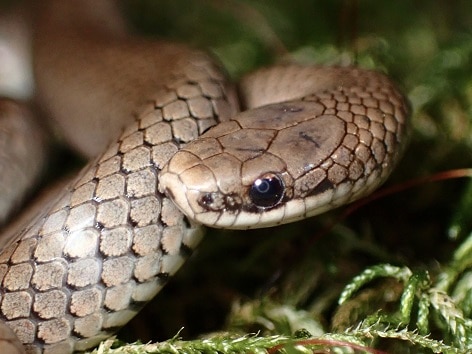
The sharp-tailed snake is isolated on the evolutionary tree, distant from the garter snakes, whipsnakes and gopher snakes alike. Perhaps there were more Contia species once, and the sharp-tailed snake is the last ice age survivor. However, there is one other member: the forest sharp-tailed snake. Also called Contia longicaudae, this went unnoticed for years due to its vast similarity, finally confirmed in 2010 as its own species.
Contia longicaudae has the same red-brown scales, beady round pupils and slender, short body as the main version. It’s equally shy, and still lives in moist forests, specifically along California-Oregon border areas. The main difference is the tail, which is significantly longer. The sharp-tailed snake has a tail 14.5% of its total body, while the forest sharp-tailed snake reaches 20%. The latter also has more scales on the underside of its tale – 43-58 versus 24-42.
There are subtle colour differences as well, particularly the black and white bands on the belly. With the forest sharp-tailed snake, they’re still present, but the black is much fainter. The signature sharp tail is as pointy as ever.
| 11 | Huddles together under shelter |
The sharp-tailed snake occupies a similar ecological niche to the ring-necked snake out east in Georgia and Louisiana. And like that species, they often take shelter together under prime spots. 11 sharp-tailed snakes have been found under a pile of boards in California, while 8 were found huddling together on Galiano Island. They also congregate to lay their eggs in the same secretive locations. Sharp-tailed snakes lay 2 to 9 eggs at once, usually in summer. The eggs measure 4.4cm on average, and are often buried in 15cm of loose soil, far below the towering trees of the forest.
The 2010 study which announced the forest species casually mentioned another subgroup as well, those in the southern Sierra Nevada. Preliminary investigations revealed a distinct genetic block, that may be an ancient short-tail lineage. Watch this space – a new sharp-tail subspecies may be born soon.
Another cool study involved scents. Scientists in a lab exposed sharp-tailed snakes to either a neutral scent, an earthworm scent, or a slug scent. They noticed the two slimy creatures just as quickly, rising to attention. But the slug scents triggered far from tongue flecking, showing that the snakes’ interest was piqued. The scientists decided that the old reports of slug-eating were accurate after all.

I found one on my patio last night. I don’t know where to take it to release it.
I’m not a conservationist, but possibly the edge of a forest directly adjacent to a grassy clearing. If it appeared in your garden then there must be suitable habitat nearby.